Tribological Properties of Porous PEEK Composites Containing Ionic Liquid under Dry Friction Condition
Abstract
:1. Introduction
2. Experiment
2.1. Material Preparation
2.2. Friction and Wear Tests
2.3. Characterizations
3. Results and Discussion
3.1. Fabrication of Porous PEEK Composites
3.2. Friction and Wear Properties
3.3. Studies of Worn Surfaces
4. Conclusions
- (1)
- In comparison with traditional PEEK composites (CF/PTFE/PEEK), porous PEEK composites containing ionic liquid show much better tribological properties.
- (2)
- CF reinforced porous PEEK containing ionic liquid (p-CF/PEEK + IL) show the lowest friction coefficient and the lowest wear mass loss, which is 27% and 0.9% of CF/PTFE/PEEK under the specific condition.
- (3)
- Long time tribological test indicates that the wear mass loss comes from the running-in period, while its wear mass loss is negligible after this period.
- (4)
- The addition of PTFE has no observed positive or a negative influence on the tribological behaviors, especially under high sliding velocity and high applied load.
Acknowledgments
Author Contributions
Conflicts of Interest
References
- Myshkin, N.; Kovalev, A.; Spaltman, D.; Woydt, M. Contact mechanics and tribology of polymer composites. J. Appl. Polym. Sci. 2014, 131, 39870. [Google Scholar] [CrossRef]
- Myshkin, N.K.; Petrokovets, M.I.; Kovalev, A.V. Tribology of polymers: Adhesion, friction, wear, and mass-transfer. Tribol. Int. 2005, 38, 910–921. [Google Scholar] [CrossRef]
- Panda, J.N.; Bijwe, J.; Pandey, R.K. Attaining high tribo-performance of PAEK composites by selecting right combination of solid lubricants in right proportions. Compos. Sci. Technol. 2017, 144, 139–150. [Google Scholar] [CrossRef]
- Nagai, J.; Saito, M.; Shibano, T. Seal Ring. U.S. Patent 9,239,113, 19 January 2016. [Google Scholar]
- Theiler, G.; Gradt, T. Environmental effects on the sliding behaviour of peek composites. Wear 2016, 368–369, 278–286. [Google Scholar] [CrossRef]
- Chang, L.; Zhang, G.; Wang, H.; Fu, K. Comparative study on the wear behaviour of two high-temperature-resistant polymers. Tribol. Lett. 2017, 65, 34. [Google Scholar] [CrossRef]
- Friedrich, K.; Zhang, Z.; Schlarb, A. Effects of various fillers on the sliding wear of polymer composites. Compos. Sci. Technol. 2005, 65, 2329–2343. [Google Scholar] [CrossRef]
- Rodriguez, V.; Sukumaran, J.; Schlarb, A.K.; De Baets, P. Influence of solid lubricants on tribological properties of polyetheretherketone (PEEK). Tribol. Int. 2016, 103, 45–57. [Google Scholar] [CrossRef]
- Chang, L.; Zhang, Z.; Ye, L.; Friedrich, K. Tribological properties of high temperature resistant polymer composites with fine particles. Tribol. Int. 2007, 40, 1170–1178. [Google Scholar] [CrossRef]
- Wang, H.; Zhu, Y.; Feng, X.; Lu, X. The effect of self-assembly modified potassium titanate whiskers on the friction and wear behaviors of peek composites. Wear 2010, 269, 139–144. [Google Scholar]
- Stolarski, T.A. External lubrication of high-temperature thermoplastic polymers. J. Appl. Polym. Sci. 1993, 48, 897–904. [Google Scholar] [CrossRef]
- Zhao, F.; Gao, C.; Wang, H.; Wang, T.; Wetzel, B.; Jim, B.-C.; Zhang, G.; Wang, Q. Tribological behaviors of carbon fiber reinforced epoxy composites under pao lubrication conditions. Tribol. Lett. 2016, 62, 1–11. [Google Scholar] [CrossRef]
- Zhao, F.; Li, G.; Zhang, G.; Wang, T.; Wang, Q. Hybrid effect of ZnS sub-micrometer particles and reinforcing fibers on tribological performance of polyimide under oil lubrication conditions. Wear 2017, 380–381, 86–95. [Google Scholar] [CrossRef]
- Zhang, G.; Wetzel, B.; Wang, Q. Tribological behavior of PEEK-based materials under mixed and boundary lubrication conditions. Tribol. Int. 2015, 88, 153–161. [Google Scholar] [CrossRef]
- Loy, X.Z.K.; Sinha, S.K. Lubrication of polyether ether ketone (PEEK) surface by liquid ultrathin films for high wear durability. Wear 2012, 296, 681–692. [Google Scholar] [CrossRef]
- Samyn, P.; De Baets, P.; Schoukens, G. Influence of internal lubricants (PTFE and silicon oil) in short carbon fibre-reinforced polyimide composites on performance properties. Tribol. Lett. 2009, 36, 135–146. [Google Scholar] [CrossRef]
- Guo, Q.B.; Lau, K.T.; Rong, M.Z.; Zhang, M.Q. Optimization of tribological and mechanical properties of epoxy through hybrid filling. Wear 2010, 269, 13–20. [Google Scholar] [CrossRef]
- Wang, H.; Zhang, S.; Wang, G.; Yang, S.; Zhu, Y. Tribological behaviors of hierarchical porous peek composites with mesoporous titanium oxide whisker. Wear 2013, 297, 736–741. [Google Scholar] [CrossRef]
- Sanes, J.; Carrión, F.J.; Bermúdez, M.D.; Martínez-Nicolás, G. Ionic liquids as lubricants of polystyrene and polyamide 6-steel contacts. Preparation and properties of new polymer-ionic liquid dispersions. Tribol. Lett. 2006, 21, 121–133. [Google Scholar] [CrossRef]
- Sanes, J.; Carrión, F.J.; Jiménez, A.E.; Bermúdez, M.D. Influence of temperature on PA 6–steel contacts in the presence of an ionic liquid lubricant. Wear 2007, 263, 658–662. [Google Scholar] [CrossRef]
- Wu, J.; Zhu, J.; Mu, L.; Shi, Y.; Dong, Y.; Feng, X.; Lu, X. High load capacity with ionic liquid-lubricated tribological system. Tribol. Int. 2016, 94, 315–322. [Google Scholar] [CrossRef]
- Li, H.; Wang, Q.; Wang, H.; Cui, Y.; Zhu, Y.; Wang, B. Fabrication of thermally stable polysulfone microcapsules containing [EMIm][NTf2] ionic liquid for enhancement of in situ self-lubrication effect of epoxy. Macromol. Mater. Eng. 2016, 301, 1473–1481. [Google Scholar] [CrossRef]
- Bandeira, P.; Monteiro, J.; Baptista, A.M.; Magalhães, F.D. Tribological performance of PTFE-based coating modified with microencapsulated [HMIM][NTf2] ionic liquid. Tribol. Lett. 2015, 59. [Google Scholar] [CrossRef]
- Saurín, N.; Sanes, J.; Bermúdez, M.D. Effect of graphene and ionic liquid additives on the tribological performance of epoxy resin. Tribol. Lett. 2014, 56, 133–142. [Google Scholar] [CrossRef]
- Zhu, Y.; Lin, S.; Wang, H.; Liu, D. Study on the tribological properties of porous sweating peek composites under ionic liquid lubricated condition. J. Appl. Polym. Sci. 2014, 131. [Google Scholar] [CrossRef]
- Zhang, G.; Yu, H.; Zhang, C.; Liao, H.; Coddet, C. Temperature dependence of the tribological mechanisms of amorphous PEEK (polyetheretherketone) under dry sliding conditions. Acta Mater. 2008, 56, 2182–2190. [Google Scholar] [CrossRef]
- Mu, L.; Shi, Y.; Feng, X.; Zhu, J.; Lu, X. The effect of thermal conductivity and friction coefficient on the contact temperature of polyimide composites: Experimental and finite element simulation. Tribol. Int. 2012, 53, 45–52. [Google Scholar] [CrossRef]
- Brostow, W.; Hagg Lobland, H.E. Materials: Introduction and Applications; John Wiley & Sons: New York, NY, USA, 2017; Chapter 19. [Google Scholar]
- Mu, L.; Feng, X.; Zhu, J.; Wang, H.; Sun, Q.; Shi, Y.; Lu, X. Comparative study of tribological properties of different fibers reinforced PTFE/PEEK composites at elevated temperatures. Tribol. Trans. 2010, 53, 189–194. [Google Scholar] [CrossRef]
- Zhang, Z.; Breidt, C.; Chang, L.; Friedrich, K. Wear of PEEK composites related to their mechanical performances. Tribol. Int. 2004, 37, 271–277. [Google Scholar] [CrossRef]
- Qu, J.; Chi, M.; Meyer, H.M.; Blau, P.J.; Dai, S.; Luo, H. Nanostructure and composition of tribo-boundary films formed in ionic liquid lubrication. Tribol. Lett. 2011, 43, 205–211. [Google Scholar] [CrossRef]
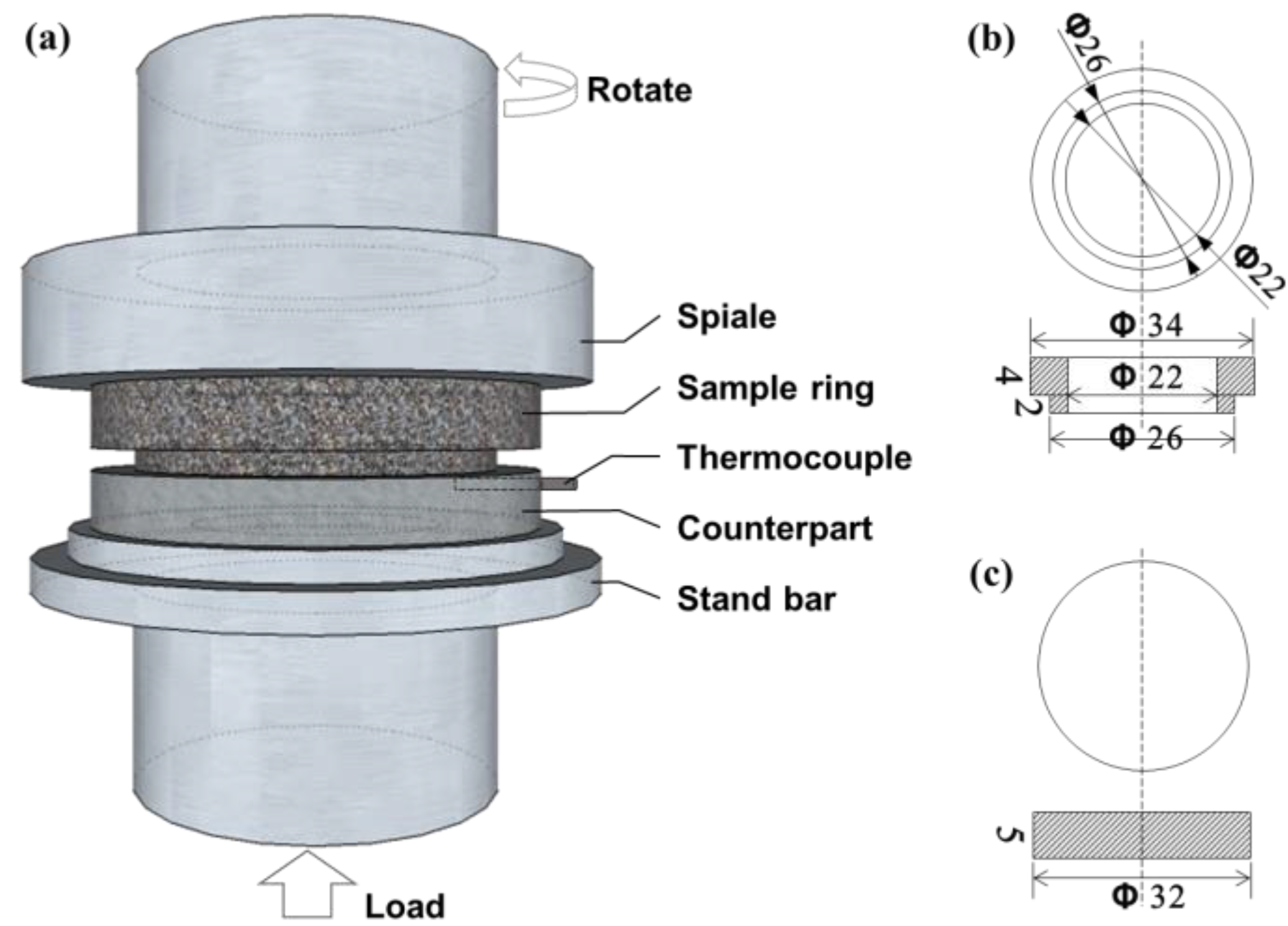
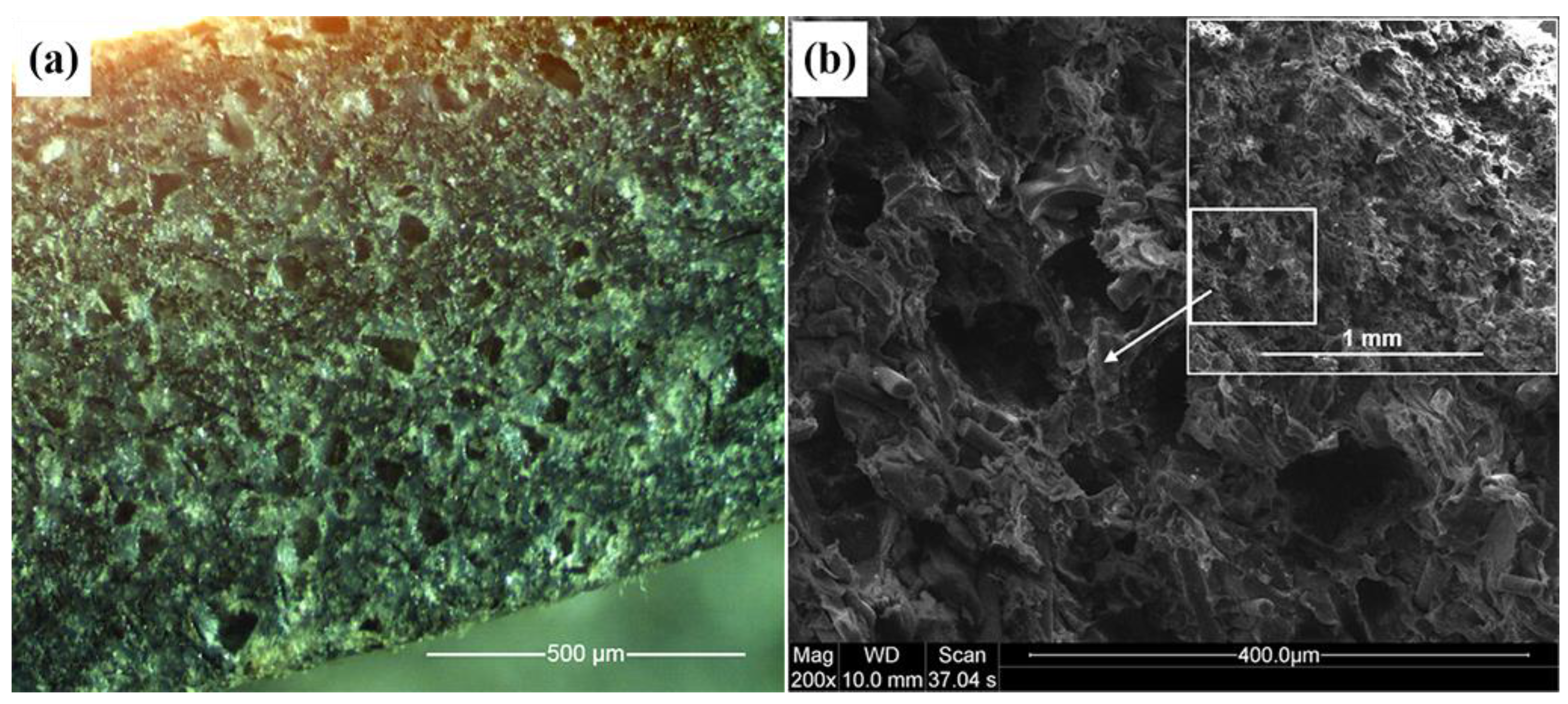
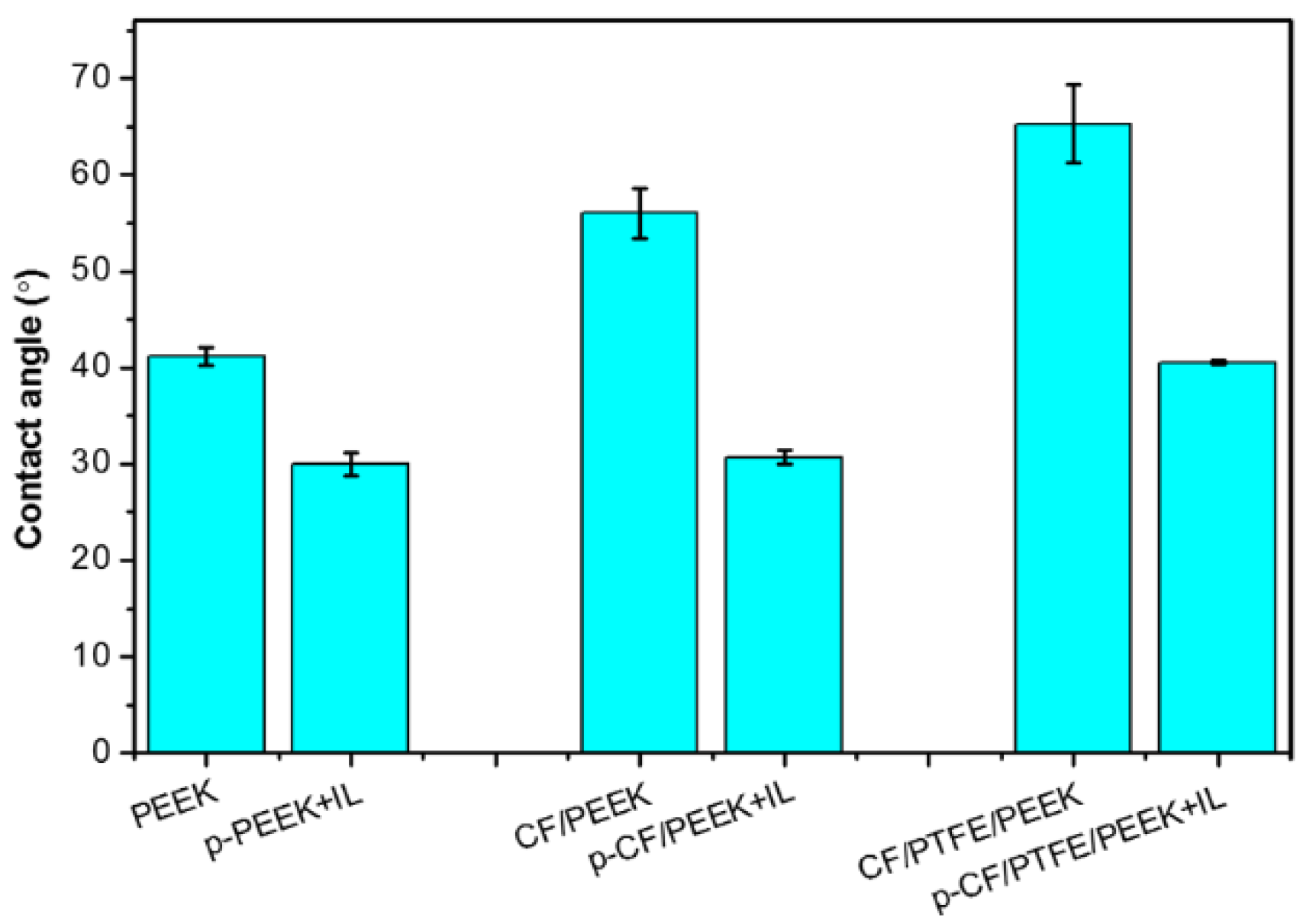
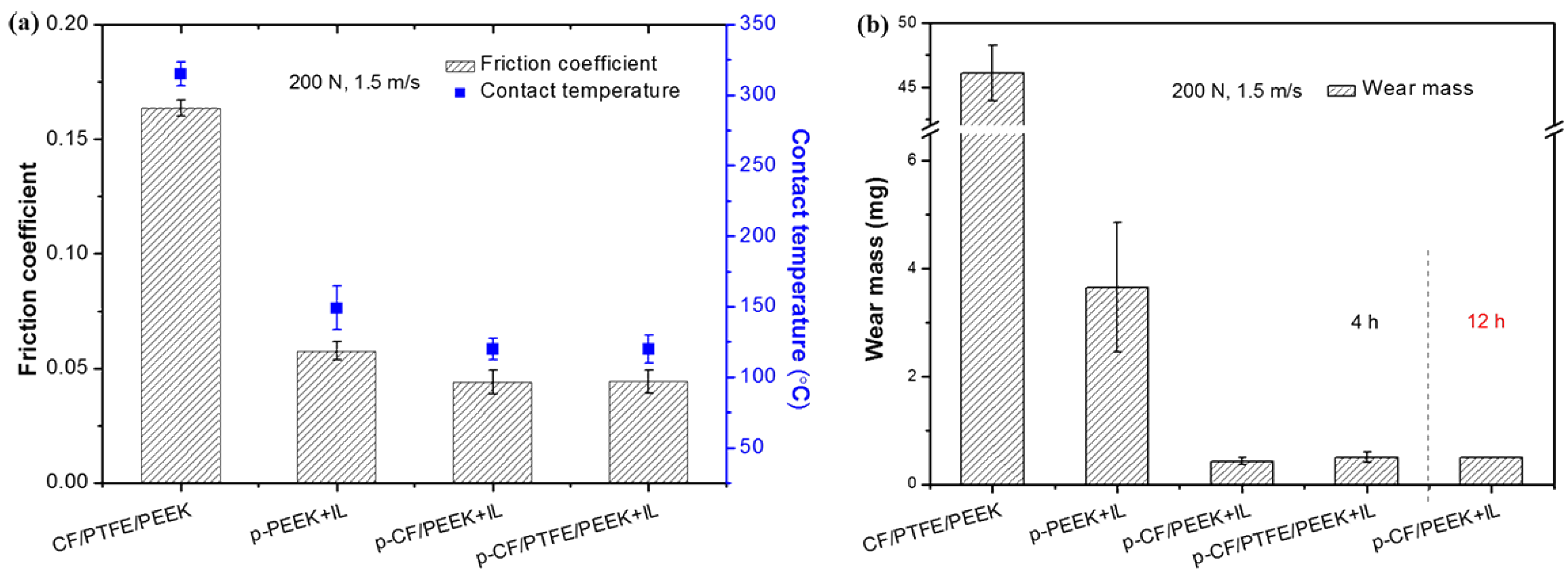

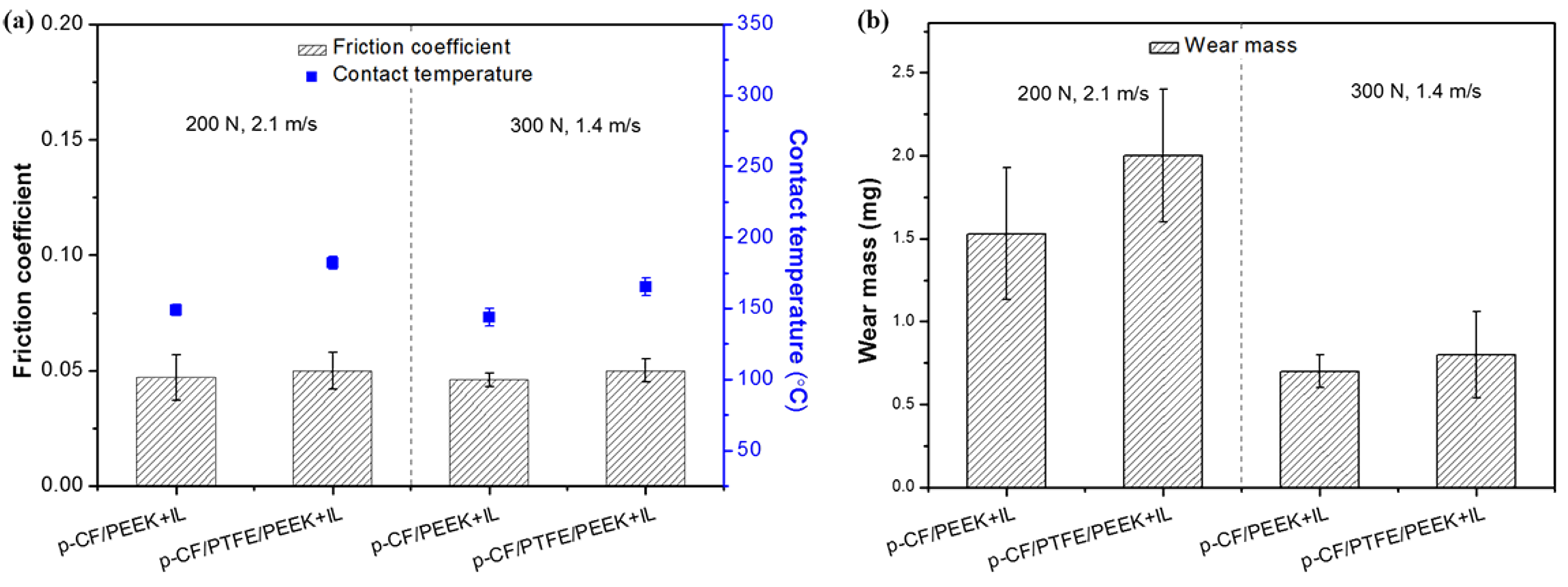
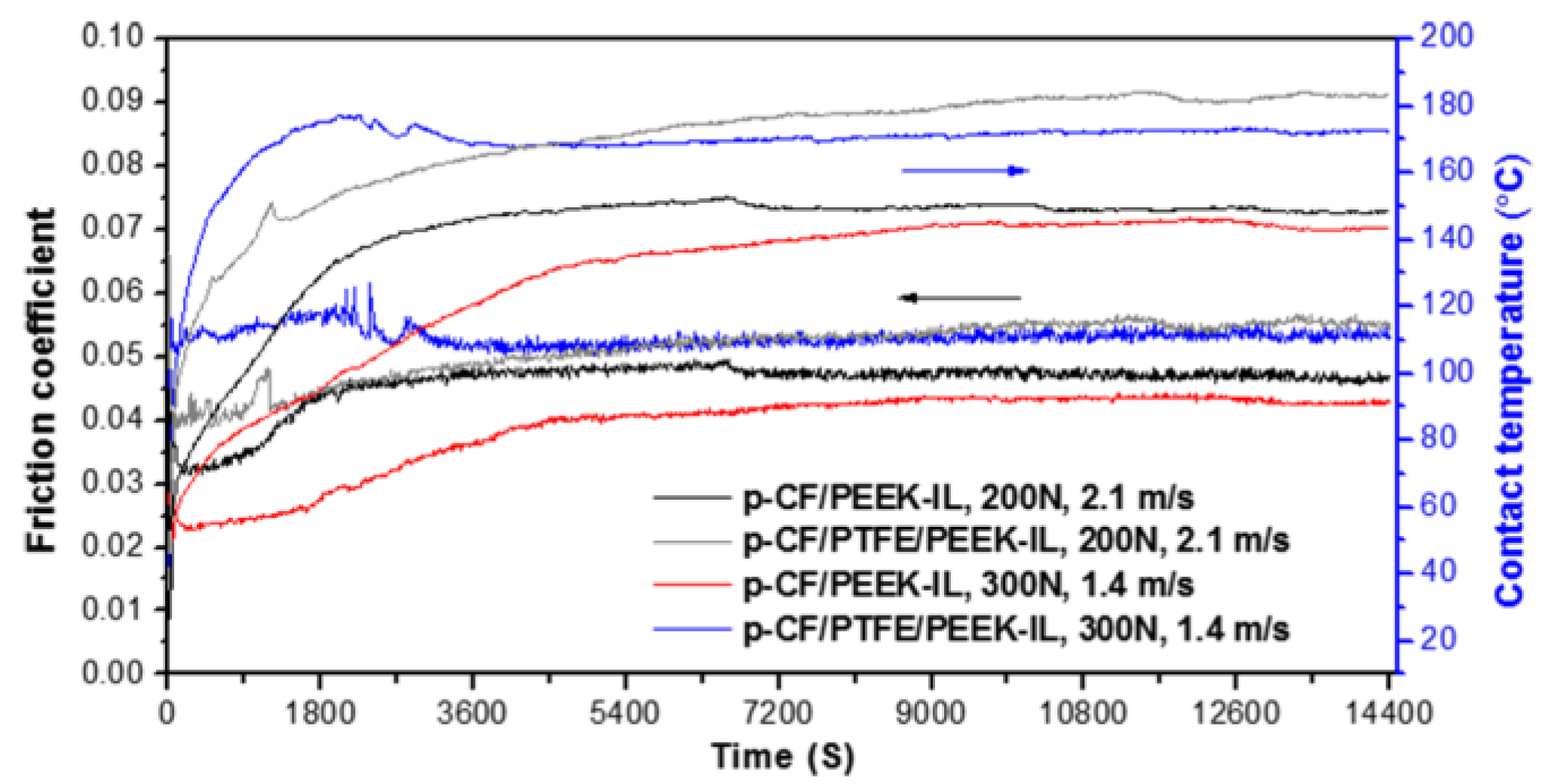
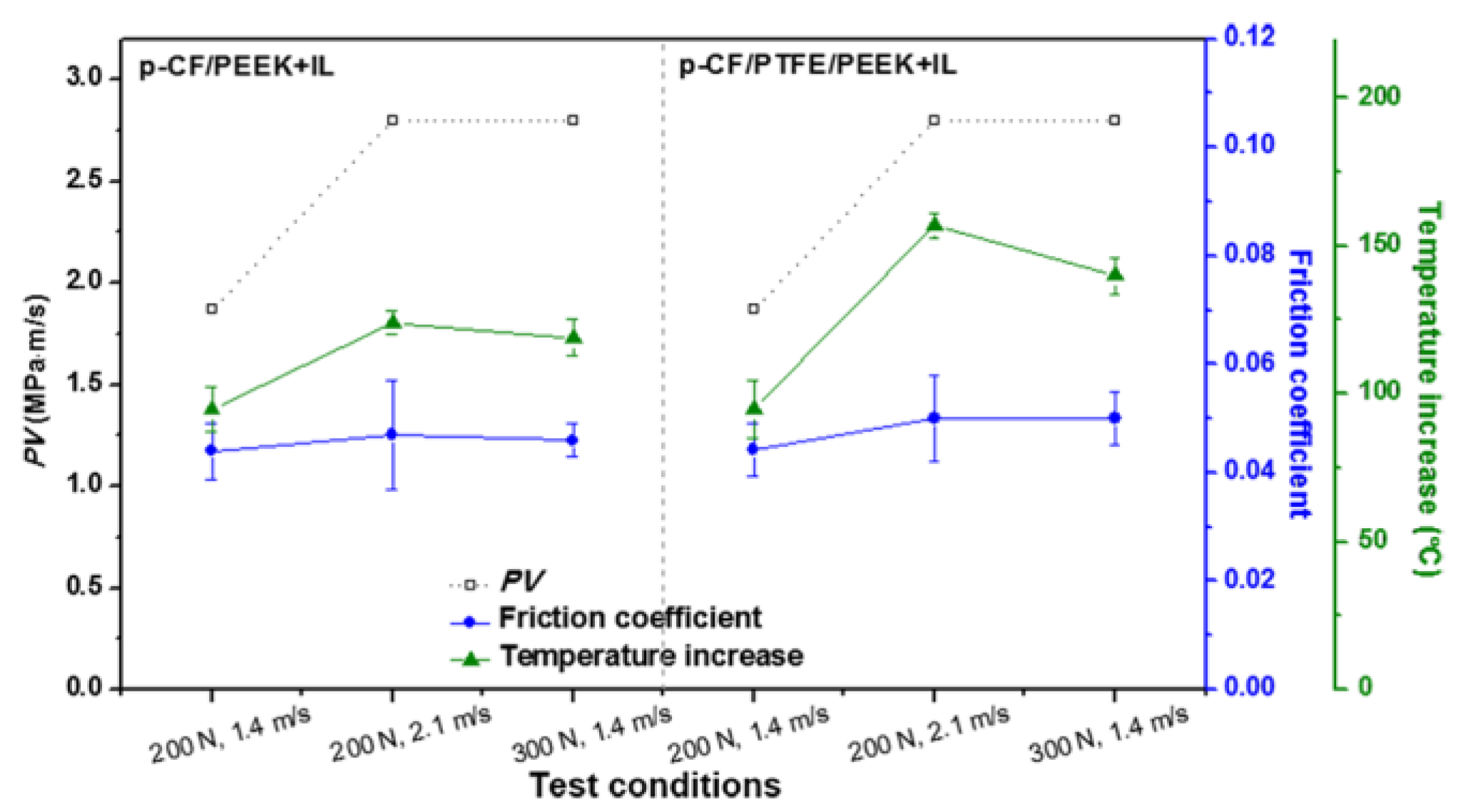
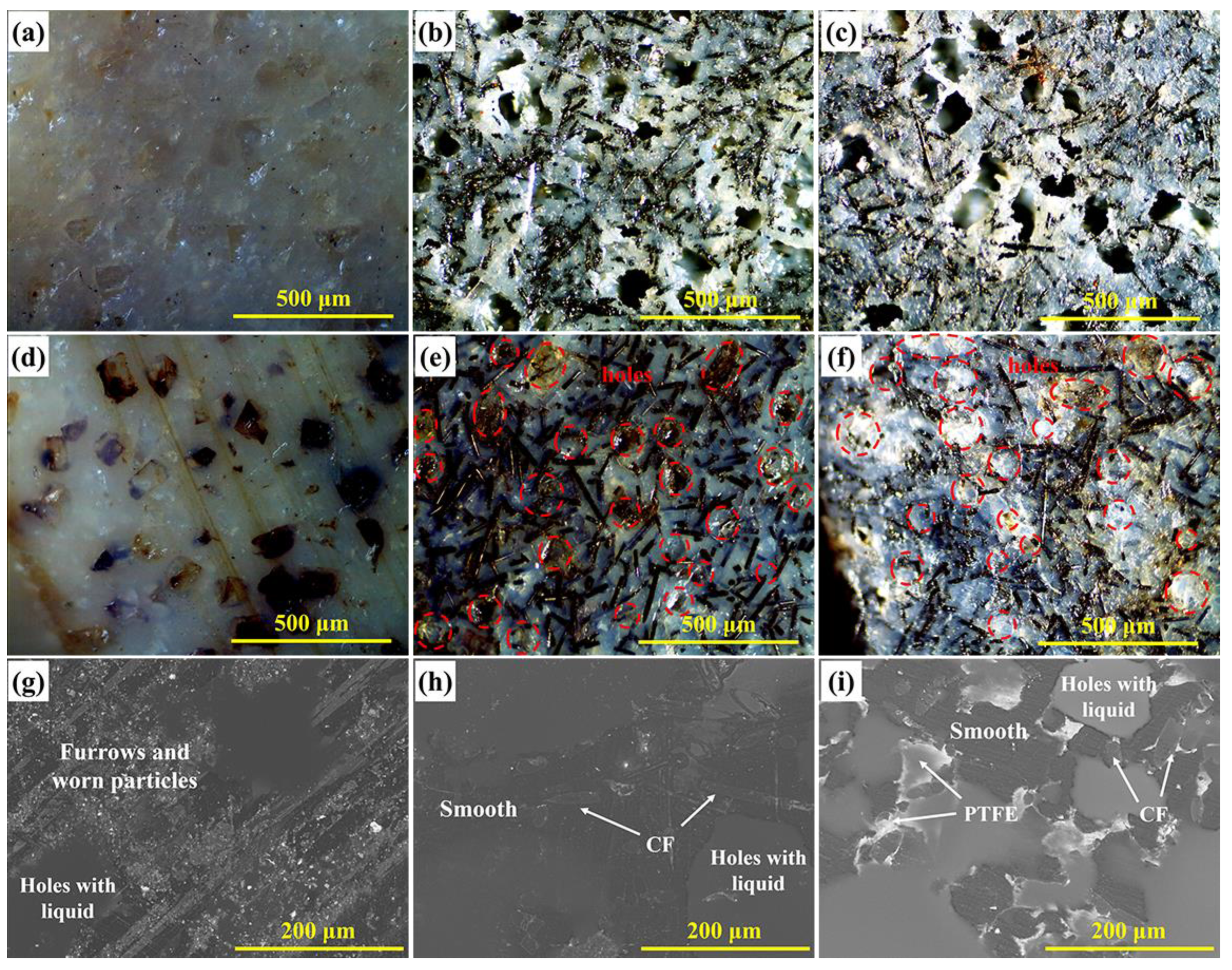

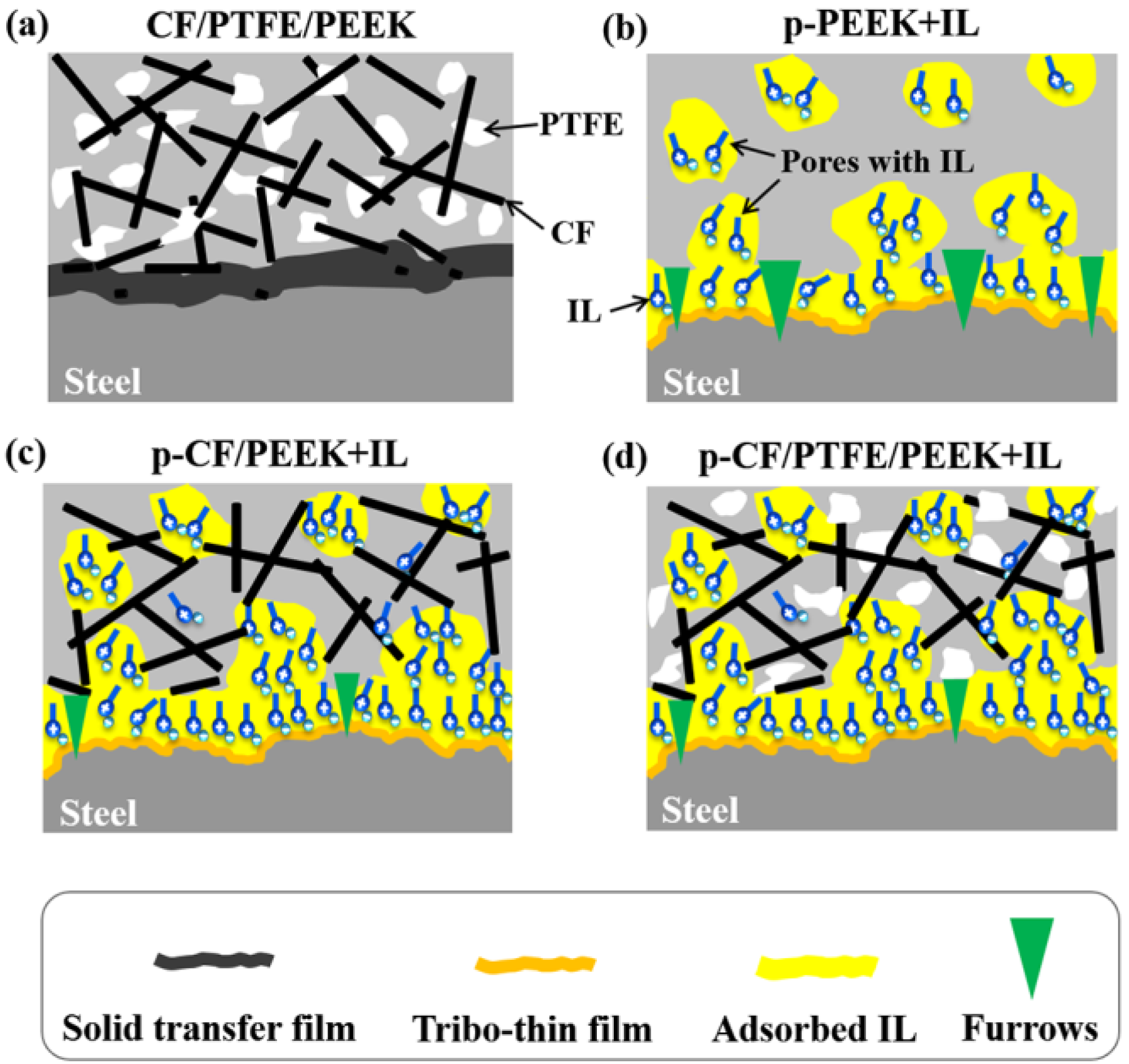
| PEEK Composites | PEEK (%) | PTFE (%) | CF (%) | NaCl (%) |
|---|---|---|---|---|
| CF/PTFE/PEEK | 70 | 15 | 15 | 0 |
| p-PEEK | 70 | 0 | 0 | 30 |
| p-CF/PEEK | 55 | 0 | 15 | 30 |
| p-CF/PTFE/PEEK | 40 | 15 | 15 | 30 |
| No. | Applied Load (N) | Linear Velocity (m/s) | PV Value (MPa·m/s) |
|---|---|---|---|
| 1 | 200 | 1.4 | 1.87 |
| 2 | 200 | 2.1 | 2.80 |
| 3 | 300 | 1.4 | 2.80 |
| PEEK Composites | p-PEEK | p-CF/PEEK | p-CF/PTFE/PEEK |
|---|---|---|---|
| IL content (wt%) | 1.1 | 2.7 | 3.4 |
© 2017 by the authors. Licensee MDPI, Basel, Switzerland. This article is an open access article distributed under the terms and conditions of the Creative Commons Attribution (CC BY) license (http://creativecommons.org/licenses/by/4.0/).
Share and Cite
Huang, X.; Wu, J.; Lu, X.; Feng, X.; Shi, Y. Tribological Properties of Porous PEEK Composites Containing Ionic Liquid under Dry Friction Condition. Lubricants 2017, 5, 19. https://doi.org/10.3390/lubricants5020019
Huang X, Wu J, Lu X, Feng X, Shi Y. Tribological Properties of Porous PEEK Composites Containing Ionic Liquid under Dry Friction Condition. Lubricants. 2017; 5(2):19. https://doi.org/10.3390/lubricants5020019
Chicago/Turabian StyleHuang, Xianzhu, Jian Wu, Xiaohua Lu, Xin Feng, and Yijun Shi. 2017. "Tribological Properties of Porous PEEK Composites Containing Ionic Liquid under Dry Friction Condition" Lubricants 5, no. 2: 19. https://doi.org/10.3390/lubricants5020019
APA StyleHuang, X., Wu, J., Lu, X., Feng, X., & Shi, Y. (2017). Tribological Properties of Porous PEEK Composites Containing Ionic Liquid under Dry Friction Condition. Lubricants, 5(2), 19. https://doi.org/10.3390/lubricants5020019







